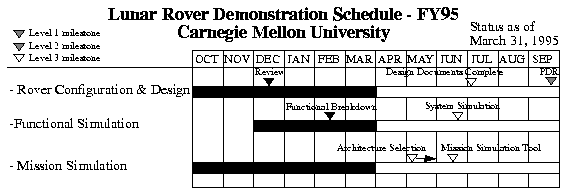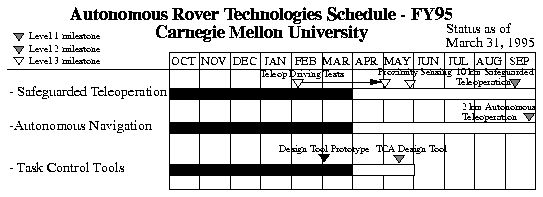The CMU Telerobotics program consists of two tasks:
Began design and development of a mission/rover simulation tool. Developed simulation architecture, completed object-oriented analysis of the tool, and produced mission specification and scripts.
In conjunction with the Mobile Robot Design course at CMU, are examining some of critical rover design issues, including power generation and distribution, night survival, and reliability. In particular, are pursuing trade-off and technology assessment studies in the following areas:
Travelled to University of Maryland to meet with the Ranger TFX group. Discussed programmatic and technical issues related to the LRD and Ranger projects. Established a mutual know-how transfer process. Created web page for Lunar Rover Initiative.
Prototype the mission simulation tool and demonstrate its use in evaluating rover designs.
Produce preliminary design of the rover, combining the efforts of the Mobile Robot Design course, modeling tool capabilities, and prototype testing.
Continue subsystem trade-off studies.

Procured proximity sensor and related computing, and began to develop techniques to interpret sensor information to detect obstacles and craters. Fixed several problems with RatlerŐs on-board computer hardware and mobility subsystems. Procured radio Ethernet, and began developing techniques to permit digital video (image) communications from Ratler.
Improved performance of stereo algorithms through code optimization and capability to have variable map resolution computed within a single image pair. Developed and compared alternative methods of map merging, and settled on one that uses both maximum likelihood and plane-fitting techniques to merge maps.
Dramatically improved interprocess communications performance in TCA, including implementation of point-to-point communications. Porting TCA to the AMX real-time operating system. Developed part of the TCA Design Tool that generates TCA message format strings from C-language type declarations.
Several papers accepted for IROS and IJCAI conferences. Created web page for Autonomous Rover Technologies project. Demonstrated Ratler teleoperation on FX morning show.
Complete development of radio Ethernet transmission of video images. Port dead-reckoning and sensor-filtering software to on-board computers.
Continue user trials to evaluate effectiveness of safeguarded teleoperation.
Develop outdoor testing site at REC for multi-kilometer navigation experiments. Conduct extensive autonomous navigation trials at the outdoor testing site.
Complete initial prototype of TCA Design Tool, which will facilitate defining communications interfaces for TCA-based systems.
